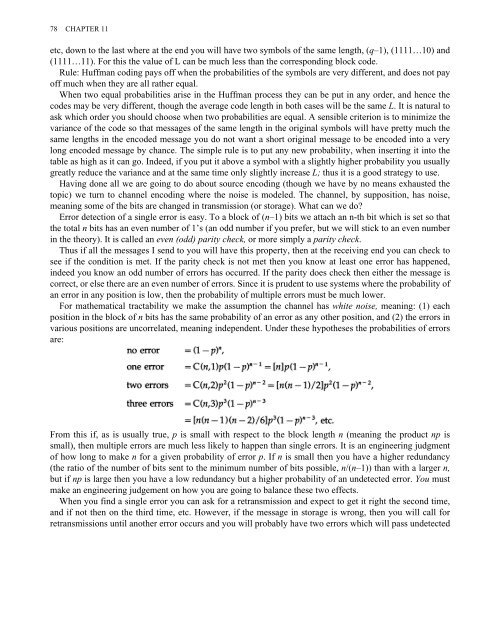hamming
hamming
hamming
You also want an ePaper? Increase the reach of your titles
YUMPU automatically turns print PDFs into web optimized ePapers that Google loves.
78 CHAPTER 11etc, down to the last where at the end you will have two symbols of the same length, (q–1), (1111…10) and(1111…11). For this the value of L can be much less than the corresponding block code.Rule: Huffman coding pays off when the probabilities of the symbols are very different, and does not payoff much when they are all rather equal.When two equal probabilities arise in the Huffman process they can be put in any order, and hence thecodes may be very different, though the average code length in both cases will be the same L. It is natural toask which order you should choose when two probabilities are equal. A sensible criterion is to minimize thevariance of the code so that messages of the same length in the original symbols will have pretty much thesame lengths in the encoded message you do not want a short original message to be encoded into a verylong encoded message by chance. The simple rule is to put any new probability, when inserting it into thetable as high as it can go. Indeed, if you put it above a symbol with a slightly higher probability you usuallygreatly reduce the variance and at the same time only slightly increase L; thus it is a good strategy to use.Having done all we are going to do about source encoding (though we have by no means exhausted thetopic) we turn to channel encoding where the noise is modeled. The channel, by supposition, has noise,meaning some of the bits are changed in transmission (or storage). What can we do?Error detection of a single error is easy. To a block of (n–1) bits we attach an n-th bit which is set so thatthe total n bits has an even number of 1’s (an odd number if you prefer, but we will stick to an even numberin the theory). It is called an even (odd) parity check, or more simply a parity check.Thus if all the messages I send to you will have this property, then at the receiving end you can check tosee if the condition is met. If the parity check is not met then you know at least one error has happened,indeed you know an odd number of errors has occurred. If the parity does check then either the message iscorrect, or else there are an even number of errors. Since it is prudent to use systems where the probability ofan error in any position is low, then the probability of multiple errors must be much lower.For mathematical tractability we make the assumption the channel has white noise, meaning: (1) eachposition in the block of n bits has the same probability of an error as any other position, and (2) the errors invarious positions are uncorrelated, meaning independent. Under these hypotheses the probabilities of errorsare:From this if, as is usually true, p is small with respect to the block length n (meaning the product np issmall), then multiple errors are much less likely to happen than single errors. It is an engineering judgmentof how long to make n for a given probability of error p. If n is small then you have a higher redundancy(the ratio of the number of bits sent to the minimum number of bits possible, n/(n–1)) than with a larger n,but if np is large then you have a low redundancy but a higher probability of an undetected error. You mustmake an engineering judgement on how you are going to balance these two effects.When you find a single error you can ask for a retransmission and expect to get it right the second time,and if not then on the third time, etc. However, if the message in storage is wrong, then you will call forretransmissions until another error occurs and you will probably have two errors which will pass undetected


